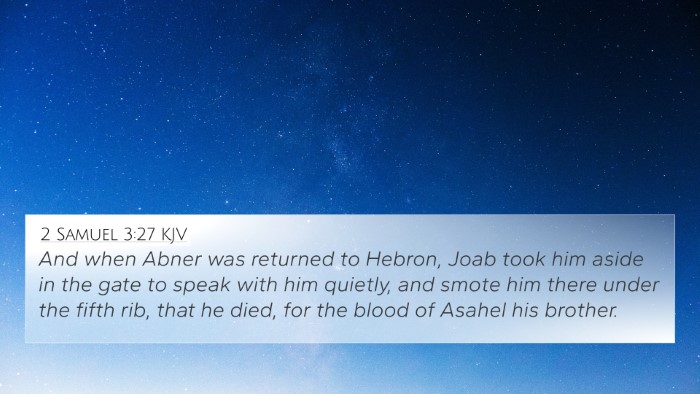Old Testament
Genesis Exodus Leviticus Numbers Deuteronomy Joshua Judges Ruth 1 Samuel 2 Samuel 1 Kings 2 Kings 1 Chronicles 2 Chronicles Ezra Nehemiah Esther Job Psalms Proverbs Ecclesiastes Song of Solomon Isaiah Jeremiah Lamentations Ezekiel Daniel Hosea Joel Amos Obadiah Jonah Micah Nahum Habakkuk Zephaniah Haggai Zechariah Malachi2 Samuel 4:6 Similar Verses
2 Samuel 4:6 Cross References
And they came thither into the midst of the house, as though they would have fetched wheat; and they smote him under the fifth rib: and Rechab and Baanah his brother escaped.
Uncover the Rich Themes and Topics of This Bible Verse
Listed below are the Bible themes associated with 2 Samuel 4:6. We invite you to explore each theme to gain deeper insights into the Scriptures.
2 Samuel 4:6 Cross Reference Verses
This section features a detailed cross-reference designed to enrich your understanding of the Scriptures. Below, you will find carefully selected verses that echo the themes and teachings related to 2 Samuel 4:6 KJV. Click on any image to explore detailed analyses of related Bible verses and uncover deeper theological insights.

2 Samuel 2:23 (KJV) »
Howbeit he refused to turn aside: wherefore Abner with the hinder end of the spear smote him under the fifth rib, that the spear came out behind him; and he fell down there, and died in the same place: and it came to pass, that as many as came to the place where Asahel fell down and died stood still.

2 Samuel 3:27 (KJV) »
And when Abner was returned to Hebron, Joab took him aside in the gate to speak with him quietly, and smote him there under the fifth rib, that he died, for the blood of Asahel his brother.

2 Samuel 20:10 (KJV) »
But Amasa took no heed to the sword that was in Joab's hand: so he smote him therewith in the fifth rib, and shed out his bowels to the ground, and struck him not again; and he died. So Joab and Abishai his brother pursued after Sheba the son of Bichri.
2 Samuel 4:6 Verse Analysis and Similar Verses
Understanding 2 Samuel 4:6
2 Samuel 4:6 presents a pivotal moment in the narrative of ancient Israel during a time of turbulent transition and power struggles. This verse highlights the deception and treachery that often accompanied the conflict over leadership, particularly in the context of Saul's house and David's rising authority. In this analysis, we will explore the verse's meaning using insights drawn from esteemed public domain commentaries.
Verse Context
2 Samuel 4:6 states:
"And they came thither into the midst of the house, as though they would have fetched wheat; and they smote him under the fifth rib: and Ahimelech and his brother Abner were their men." (KJV)
This context reveals a plot against Ishbosheth, King Saul's surviving son, and illustrates the brutal nature of political struggles in the period following Saul's death.
Commentary Insights
In synthesizing the perspectives of Matthew Henry, Albert Barnes, and Adam Clarke, several key themes emerge:
-
Deception and Betrayal:
Matthew Henry emphasizes the cunning nature of the individuals involved, suggesting that they presented themselves innocently to carry out their malicious intentions. This notion of deceptive appearance raises questions about integrity and morality in leadership.
-
Moral Implications:
Albert Barnes discusses the moral deterioration that led to such treachery. The willingness to resort to murder for political gain reflects the desperate measures individuals will take in the pursuit of power, showcasing a broader theme of corruption in leadership.
-
Divine Sovereignty:
Adam Clarke points out that despite the actions of these men, God's sovereignty still plays a crucial role in the unfolding of events. God’s overarching plan cannot be thwarted by human deceit.
-
Human Nature:
All three commentators highlight that this act reveals much about human nature—susceptible to pride, ambition, and the desire for power. This offers a timeless lesson on the potential moral pitfalls of leadership.
Cross-References and Thematic Connections
This verse connects with several others in Scripture that reflect similar themes of betrayal, power struggles, and God's divine authority:
- 1 Samuel 26:8: Highlights the treachery and ambition surrounding King Saul and his pursuit of David.
- 2 Samuel 3:30: Discusses the conflict between Abner and Joab, further emphasizing the division within Israel.
- Proverbs 12:5: Offers wisdom about the righteousness of the plans of the just versus the counsels of the wicked.
- Romans 13:1-2: Discusses God’s authority over earthly authorities, reminding readers of the divine order amidst chaos.
- Psalms 37:12-13: Illustrates the Lord's awareness of the wicked schemes against the righteous, reinforcing God’s control over human actions.
- Matthew 26:14-15: The betrayal of Jesus by Judas, showcasing the theme of treachery throughout the biblical narrative.
- Acts 2:23: Peter speaks about the predetermined plan of God in relation to the betrayal of Jesus, reflecting on divine sovereignty in human betrayal.
- Hebrews 10:31: Warns of the consequences of falling into the hands of the living God, reflecting on God's judgment against treachery and sin.
- James 4:1-2: Discusses the source of quarrels and conflicts among people, tying back to human ambition and desires.
- Isaiah 53:3: This verse foreshadows betrayal and suffering, connecting the suffering servant with the themes of betrayal found throughout Scripture.
Tools for Understanding and Studying Connections
For those engaged in a deeper study of the Scriptures and the connection between various passages, several tools and resources are essential:
- Bible Concordance: An essential tool for finding reference verses quickly and understanding their context.
- Cross-Reference Bible Study: Engaging with a system that allows for examination of themes and connections between verses.
- Cross-Reference Guide: Books and guides that help identify thematic links across different books and covenants within the Bible.
- Bible Reference Resources: Online and in-print materials that provide thematic indexes and tables of scripture connections.
- Bible Chain References: A method of studying scriptures in a linked sequence to explore semi-related themes and teachings.
- Comparative Bible Verse Analysis: A study method focusing on the comparison of verses from the Old Testament with their New Testament fulfillments.
- How to Use Bible Cross-References: Learning the mechanics of utilizing cross-references can enhance one's understanding of biblical narratives and themes.
- Identifying Connections between Old and New Testament: Recognizing how events and prophecies relate across Testaments brings a fuller understanding of Scripture.
- Inter-Biblical Dialogue: Analyzing dialogues and connections between different biblical texts and authors, contributing to a richer biblical narrative.
Conclusion
In summary, 2 Samuel 4:6 serves as a powerful reminder of the treacherous nature of political ambition and the overarching sovereignty of God in human affairs. By studying this verse alongside other related texts, believers can more fully grasp the implications of human actions towards divine purposes. Utilizing tools for cross-referencing and thematic analysis, readers can deepen their understanding of scripture and its continued relevance in their lives today.


